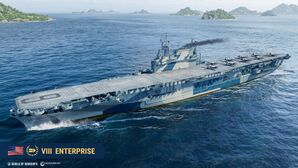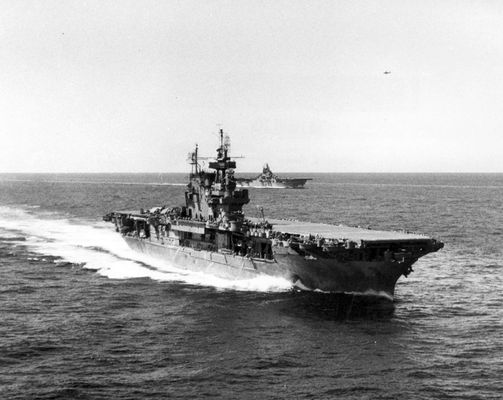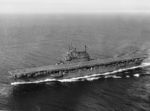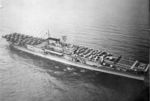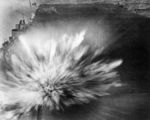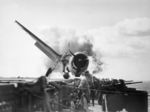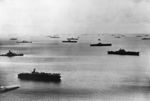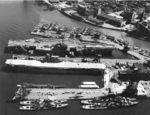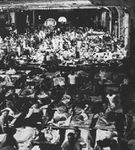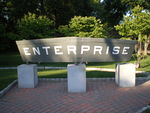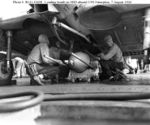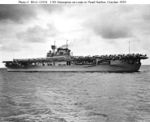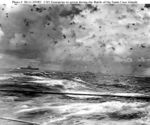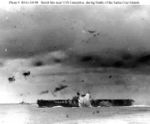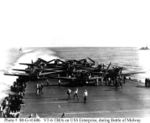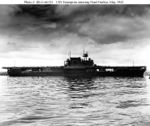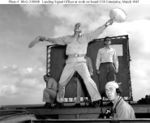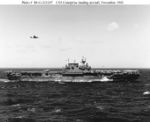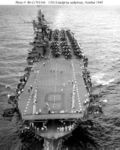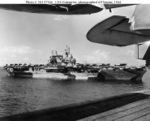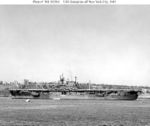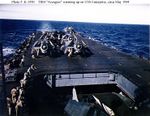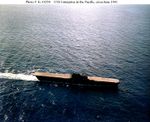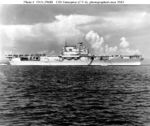Enterprise
| Revision as of 00:47, 9 September 2017 added images | Revision as of 11:34, 23 August 2020 | |||
22 intermediate revisions by 11 users not shown | ||||
| Line 4: | Line 4: | |||
| |Anno=<!-- you can write below short description for the ship. it will replace default once. --> | |Anno=<!-- you can write below short description for the ship. it will replace default once. --> | |||
| ? | A ''Yorktown''-class strike aircraft carrier that combined a number of key characteristics typical for this type of ship: a large air group, superbly assembled take-off and landing equipment that allowed it to launch a large number of squadrons, good speed, and powerful AA defenses. <br><br> ''Enterprise'' first went on sale on both the NA and EU servers on 30 June 2017. | + | A ''Yorktown''-class strike aircraft carrier that combined a number of key characteristics typical for this type of ship: a large air group, superbly assembled take-off and landing equipment that allowed it to launch a large number of squadrons, good speed, and powerful AA defenses. <br><br> ''Enterprise'' first went on sale on both the NA and EU servers on 30 June 2017. She was re-released on for sale soon after update 8.0, but has since been removed from sale.<br><br>{{Model3DViewer|5b55e313016748d9b258be53f8cfae3d}} | |
| |Performance=<!-- write text about performance in battles below --> | |Performance=<!-- write text about performance in battles below --> | |||
| ? | ||||
| ? | ||||
| ? | ||||
| ? | ||||
| ? | ||||
| ? | ||||
| ? | ||||
| ? | ||||
| ? | ||||
| ? | ||||
| |Pros=<!-- write list of positive points below. use * as in ordinary wiki-list. --> | |Pros=<!-- write list of positive points below. use * as in ordinary wiki-list. --> | |||
| ? | * | + | * Very quick attack aircraft and torpedo bomber restoration time | |
| ? | + | * Good healthpool for all plane types | ||
| ? | * | + | * {{Patrol Fighter}}s deploy in numbers and with a range higher than all other Tier 8 aircraft carriers | |
| ? | * | + | * Attack aircraft deploy in very large squadrons - a single squadron can drop as many as four times in a row | |
| ? | * | + | * Dive bombers drop six (6) bombs per attack run | |
| ? | * | + | * Torpedo bombers drop three (3) torpedoes per attack run | |
| + | * Powerful short and mid range AA suites | |||
| + | * Good ship speed and rudder shift time | |||
| |Cons=<!-- write list of negative points below. use * as in ordinary wiki-list. --> | |Cons=<!-- write list of negative points below. use * as in ordinary wiki-list. --> | |||
| ? | * | + | * Dive bombers use AP bombs, not as versatile as HE bombs used by other American aircraft carriers | |
| ? | * | + | * Individually, AP bombs have fairly low damage and penetration | |
| ? | * | + | * Attack aircraft squadrons, having a large hitbox, are vulnerable to AA flak bursts | |
| ? | * | + | * Torpedo bombers and dive bombers have poor speed | |
| ? | * | + | * Fragile ship hull with fairly bad concealment | |
| + | * Long range AA suite is quite poor | |||
| |Research=<!-- write text about priority sequence of research below --> | |Research=<!-- write text about priority sequence of research below --> | |||
| Line 37: | Line 30: | |||
| |OptimalConfiguration=<!-- write some general text about selection of optimal configuration below (optional)--> | |OptimalConfiguration=<!-- write some general text about selection of optimal configuration below (optional)--> | |||
| ? | + | '''Due to the recent CV rework this section is under construction.''' | ||
| |Upgrades=<!-- write text about best upgrades below --> | |Upgrades=<!-- write text about best upgrades below --> | |||
| ? | ||||
| ? | ||||
| ? | ||||
| ? | ||||
| ? | ||||
| ? | ||||
| ? | ||||
| ? | ||||
| ? | ||||
| ? | ||||
| ? | ||||
| ? | ||||
| ? | ||||
| |CommanderSkills=<!-- write text about best set of Commander Skills below --> | |CommanderSkills=<!-- write text about best set of Commander Skills below --> | |||
| + | The following information is provided for players who wish to create a permanent captain for the ship. Those players who are retraining captains or using the ship to gain extra experience for a captain should consult the page relevant to the ship to which the captain will be assigned. | |||
| ? | {{Commander Skills | + | {{Commander Skills 2 | |
| ? | | Priority Target | + | <!-- The '0' rating (Not Recommended) is enabled. Use it for skills that have no effect (e.g. SSE on a CV) or are detrimental to the ship - not because you don't like it. --> | |
| ? | | | + | | rating11 = <!-- Priority Target --> | |
| ? | | Expert Loader | + | | rating12 = 0 <!-- Preventive Maint --> | |
| ? | | | + | | rating13 = 0 <!-- Expert Loader --> | |
| ? | | Direction Center for | + | | rating14 = 3 <!-- Air Supremacy --> | |
| ? | | | + | | rating15 = <!-- Direction Center for Fighters --> | |
| ? | | Incoming Fire Alert | + | | rating16 = 2 <!-- Improved Engine Boost --> | |
| ? | | | + | | rating17 = 0 <!-- Incoming Fire Alert --> | |
| + | | rating18 = 2 <!-- Last Gasp --> | |||
| ? | | High Alert | + | | rating21 = <!-- High Alert --> | |
| ? | | Jack of All Trades | + | | rating22 = <!-- Jack of All Trades --> | |
| ? | | Expert Marksman | + | | rating23 = 0 <!-- Expert Marksman --> | |
| ? | | | + | | rating24 = 3 <!-- Torpedo Acceleration --> | |
| ? | | Smoke Screen Expert | + | | rating25 = 0 <!-- Smoke Screen Expert --> | |
| ? | | | + | | rating26 = 3 <!-- Improved Engines --> | |
| ? | | Adrenaline Rush | + | | rating27 = <!-- Adrenaline Rush --> | |
| ? | | Last Stand | + | | rating28 = 0 <!-- Last Stand --> | |
| ? | | Basics of Survivability | + | | rating31 = <!-- Basics of Survivability --> | |
| ? | | Survivability Expert | + | | rating32 = 3 <!-- Survivability Expert--> | |
| ? | | Torpedo Armament Expertise | + | | rating33 = 0 <!-- Torpedo Armament Expertise--> | |
| ? | | | + | | rating34 = 3 <!-- Aircraft Armor --> | |
| ? | | Basic Firing Training | + | | rating35 = <!-- Basic Firing Training --> | |
| ? | | | + | | rating36 = <!-- Superintendent --> | |
| ? | | Demolition Expert | + | | rating37 = 2 <!-- Demolition Expert --> | |
| ? | | | + | | rating38 = 0 <!-- Vigilance --> | |
| ? | | Manual Fire Control for Secondary Armament | + | | rating41 = 0 <!-- Manual Fire Control for Secondary Armament --> | |
| ? | | Fire Prevention | + | | rating42 = <!-- Fire Prevention --> | |
| ? | | Inertia Fuse for HE Shells | + | | rating43 = 0 <!-- Inertia Fuse for HE Shells --> | |
| ? | | | + | | rating44 = 3 <!-- Sight Stabilization --> | |
| ? | | Advanced Firing Training | + | | rating45 = 1 <!-- Advanced Firing Training --> | |
| ? | | | + | | rating46 = 0 <!-- Massive AA Fire --> | |
| ? | | Radio Position Finding | + | | rating47 = 0 <!-- Radio Position Finding --> | |
| ? | | Concealment Expert | + | | rating48 = 2 <!-- Concealment Expert --> | |
| }} | }} | |||
| |Consumables=<!-- write text about selection of Consumables below --> | |Consumables=<!-- write text about selection of Consumables below --> | |||
| ? | + | ''{{#var:ship_name}}'' has access to the following consumables: | ||
| ? | * | + | * '''Slot 1:''' {{Damage Control Party}} unlimited | |
| ? | * | + | * '''Slot 2:''' {{CAP Fighter}} 4 | |
| + | All aircraft carrier consumables are automatically activated. | |||
| + | <br />'''Attack Aircraft:''' | |||
| + | * '''Slot 1:''' {{Engine Cooling}} 2 | |||
| + | * '''Slot 2:''' {{Patrol Fighter}} 3 | |||
| ? | + | '''Torpedo Bombers:''' | ||
| + | * '''Slot 1:''' {{Engine Cooling}} 2 | |||
| + | * '''Slot 2:''' {{Patrol Fighter}} 3 | |||
| + | * '''Slot 3:''' {{In-flight Repair}} 3 | |||
| + | ||||
| + | '''Bombers:''' | |||
| + | * '''Slot 1:''' {{Engine Cooling}} 2 | |||
| + | * '''Slot 2:''' {{Patrol Fighter}} 3 | |||
| |Camouflage=<!-- write text about useful camouflage below --> | |Camouflage=<!-- write text about useful camouflage below --> | |||
| Line 105: | Line 98: | |||
| |Signals=<!-- write text about best set of signals below --> | |Signals=<!-- write text about best set of signals below --> | |||
| ? | As a carrier, ''Enterprise'' is able to mount a maximum of four signal flags simultaneously and has no risk of detonating. India X-Ray, Victor Lima, and Juliet Whiskey Unaone flags are recommended to increase fire and flooding chances. November Echo Setteseven flags are also recommended to improve the ship’s anti-aircraft defenses and survivability of the strike aircraft squadrons against enemy fighters. Economic flags such as Equal Speed Charlie London and Zulu can be mounted to increase the ship’s experience and credit gain per battle. Special flags can also be mounted to further increase after-battle rewards. | + | As a carrier, ''Enterprise'' is able to mount a maximum of four signal flags simultaneously and has no risk of detonating. India X-Ray ({{India X-Ray|Size=18px}}), Victor Lima ({{Victor Lima|Size=18px}}), and Juliet Whiskey Unaone ({{Juliet Whiskey Unaone|Size=18px}}) flags are recommended to increase fire and flooding chances. November Echo Setteseven ({{November Echo Setteseven|Size=18px}}) flags are also recommended to improve the ship’s anti-aircraft defenses and survivability of the strike aircraft squadrons against enemy fighters. Economic flags such as Equal Speed Charlie London ({{Equal Speed Charlie London|Size=18px}}) and Zulu ({{Zulu|Size=18px}}) can be mounted to increase the ship’s experience and credit gain per battle. Special flags can also be mounted to further increase after-battle rewards. | |
| {{Signal Flags | {{Signal Flags | |||
| Line 150: | Line 143: | |||
| File:Enterprice Starship (port).jpg|Enterprice (Enterprise) Starship at port | File:Enterprice Starship (port).jpg|Enterprice (Enterprise) Starship at port | |||
| File:Enterprice Starship (battle).jpg|Enterprice (Enterprise) Starship in battle out in space | File:Enterprice Starship (battle).jpg|Enterprice (Enterprise) Starship in battle out in space | |||
| + | File:PCEE109_Enterprise_Flag.png|Legacy of ''Enterprise'' [[Ship:Flags#List_of_Ship_Flags|Flag]]. Given to players who purchased a special bundle containing ''Enterprise''. | |||
| </gallery> | </gallery> | |||
| Line 157: | Line 151: | |||
| <h2>USS ''Enterprise'', 1944</h2> | <h2>USS ''Enterprise'', 1944</h2> | |||
| ===Construction=== | ===Construction=== | |||
| ? | :Builder: Newport News Shipbuilding and Drydock Co., | + | :Builder: Newport News Shipbuilding and Drydock Co.,<br> Newport News, Virginia, USA | |
| ? | + | |||
| :Laid down: 16 July 1934 | :Laid down: 16 July 1934 | |||
| ? | :Launched: 3 October 1936 | + | :Launched: 3 October 1936 | |
| :Commissioned: 12 May 1938 | :Commissioned: 12 May 1938 | |||
| ---- | ---- | |||
| ===Specifications=== | ===Specifications=== | |||
| ? | : | + | :Displacement: 19,875 tons, standard | |
| :251.38m length | :251.38m length | |||
| :33.37m beam | :33.37m beam | |||
| Line 185: | Line 178: | |||
| ====Armament==== | ====Armament==== | |||
| =====Secondary===== | =====Secondary===== | |||
| ? | :Eight ( | + | :Eight (8x1) 127mm/38 Mark 12 | |
| =====Anti-Aircraft===== | =====Anti-Aircraft===== | |||
| ? | :Forty ( | + | :Forty (8x2, 6x4) 40mm Bofors | |
| ? | :Fifty ( | + | :Fifty (50x1) 20mm Oerlikon | |
| ---- | ---- | |||
| ====Aircraft==== | ====Aircraft==== | |||
| Line 206: | Line 199: | |||
| }} | }} | |||
| </div> | </div> | |||
| ? | [[File:Big_e_profile.jpg| | + | [[File:Big_e_profile.jpg|none|frame|x400px|link=|USS ''Enterprise'' (CV-6) (foreground) and USS ''[[Lexington]]'' (CV-16) in the Central Pacific, June 1944.]] | |
| ===Design=== | ===Design=== | |||
| Line 213: | Line 206: | |||
| 20,000 tons per ship was a sufficient compromise that allocated enough tonnage to apply armor deemed adequate by the Navy. The focus of the armor was to ensure that it would be able to mitigate damage from shells of 152mm caliber and below. As such, both the main armor belt and the transverse bulkheads that covered the citadel were 102mm thick. In consequence the horizontal protection was limited; a main deck 38mm thick at best. Furthermore, a torpedo bulge was placed on top of the main belt. It was of a triple chamber design: the inner layer was filled with air to dampen the impact, and the outer two layers were filled with fluids to spread out the shock. The system could mitigate explosions under 400lbs of TNT, about half of what a battleship can sustain. | 20,000 tons per ship was a sufficient compromise that allocated enough tonnage to apply armor deemed adequate by the Navy. The focus of the armor was to ensure that it would be able to mitigate damage from shells of 152mm caliber and below. As such, both the main armor belt and the transverse bulkheads that covered the citadel were 102mm thick. In consequence the horizontal protection was limited; a main deck 38mm thick at best. Furthermore, a torpedo bulge was placed on top of the main belt. It was of a triple chamber design: the inner layer was filled with air to dampen the impact, and the outer two layers were filled with fluids to spread out the shock. The system could mitigate explosions under 400lbs of TNT, about half of what a battleship can sustain. | |||
| ? | In order to simplify design, the aviation facilities for the Yorktown | + | In order to simplify design, the aviation facilities for the ''Yorktown'' class were similar to the ones used on ''Ranger''. Therefore, the single deck hangar was built on top of the hull with the main deck used as the hangar deck, and the flight deck was unarmored and built on top of the hangar. The hangar itself was built using light steel and not fully enclosed; many of the side plates were on rollers and could be pushed away to expose the internals. This had a benefit: aircraft could be warmed up while they were still inside the hangar, and during combat fires could be properly ventilated and debris thrown out. As standard fleet carriers, the ''Yorktown'' class had three elevators across the flight deck and two steam catapults positioned forward. Interestingly, there was a third catapult – in the hangar deck – to launch scouting aircraft if the flight deck was occupied. | |
| ? | Originally as designed, the ''Yorktown''-class would carry 84 aircraft plus 6 in reserve; complement in 1938 was 18 fighters, 35 torpedo bombers, and 37 dive | + | Originally as designed, the ''Yorktown''-class carriers would carry 84 aircraft plus 6 in reserve; complement in 1938 was 18 fighters, 35 torpedo bombers, and 37 dive bombers. Initially dive bombers were the lion’s share of aircraft aboard due to US carrier doctrine assigning dive bombers both the roles of scouts and of bombers. In fact, initially there would be separate dive bomber squadrons solely for either scouting or bombing. By late in the war, the on-board complement heavily favored fighters, as by then the largest threat to a carrier task force were kamikaze aircraft. | |
| ? | US aircraft carriers were known for their impressive islands and the ''Yorktown'' | + | US aircraft carriers were known for their impressive islands and the ''Yorktown'' class was no exception. The starboard structure contained the centers for command, navigation, aircraft and fire control. Furthermore – a first for any US aircraft carrier – the island had an integrated funnel. | |
| ? | As US carrier doctrine became more offensive in nature, it was realized that high-speeds was a necessary trait for a fleet carrier to possess. A speed above 30 knots would allow it to keep pace with the newly constructed [[North Carolina|treaty battleships]]. Designers elected to install 9 boilers and 4 turbines, with the fire rooms placed ahead of the engine rooms. This simplified design but was proven to be prone to damage. In speed trails, the carriers could easily achieve 120,000 shaft horsepower, which enabled a speed of about 33 knots. | + | As US carrier doctrine became more offensive in nature, it was realized that high-speeds was a necessary trait for a fleet carrier to possess. A speed above 30 knots would allow it to keep pace with the newly constructed [[North Carolina|treaty battleships]]. Designers elected to install nine (9) boilers and four (4) turbines, with the fire rooms placed ahead of the engine rooms. This simplified design but was proven to be prone to damage. In speed trails, the carriers could easily achieve 120,000 shaft horsepower, which enabled a speed of about 33 knots. | |
| ? | Even though aircraft are considered the ‘main weapons’ of a carrier, the ''Yorktown'' | + | Even though aircraft are considered the ‘main weapons’ of a carrier, the ''Yorktown'' class had a plethora of self-defense artillery. For long-range engagement, the carriers carried the novel 127mm/38 DP guns in eight (8) single-mounts. Their combat record would prove them to be excellent performing rifles. They were positioned in sponsons off the deck, which limited firing arcs, but did not obstruct the operations of the aircraft. Originally the class was equipped with M2 12.7mm machine guns in 24 single-mounts and 28mm/75 DP guns in 4 quad-mounts for short and intermediate-ranged defense, respectively. The 28mm guns were positioned fore and aft of the island, and the 12.7mm were positioned on the peripheries of the flight deck. | |
| ? | Throughout her service life, ''Enterprise'' underwent constant modifications to keep up with the rigors of combat. Most significantly, a CXAM-1 radar set was installed in 1940. Radar sets were crucial for the successes of US carriers; early target acquisition and proper management of combat air patrols increased carrier survivability. By 1942, ''Enterprise'' had her hangar catapult removed – as it was useless – and her wooden crash barriers were replaced with canvas ones; they caused less damage to the aircraft, the ship, and the pilot. Constant alteration of her AA armament was a common theme. From the start, the machine guns lacked hitting power, and the 28mm guns had poor performance. With modifications starting in 1942 she replaced her 12.7mm guns with | + | Throughout her service life, ''Enterprise'' underwent constant modifications to keep up with the rigors of combat. Most significantly, a CXAM-1 radar set was installed in 1940. Radar sets were crucial for the successes of US carriers; early target acquisition and proper management of combat air patrols increased carrier survivability. By 1942, ''Enterprise'' had her hangar catapult removed – as it was useless – and her wooden crash barriers were replaced with canvas ones; they caused less damage to the aircraft, the ship, and the pilot. Constant alteration of her AA armament was a common theme. From the start, the machine guns lacked hitting power, and the 28mm guns had poor performance. With modifications starting in 1942 she replaced her 12.7mm guns with thirty – and later fifty – Oerlikon 20mm auto-cannons. In 1943, she underwent a major refit. This brief respite allowed the crews to replace the 28mm with forty Bofors 40mm autocannons. The Mark 33 fire directors were replaced for the newer Mark 38, which could not only track fast moving targets, but low-flying targets as well. Along with a Combat Information Center installed in the island, ''Enterprise'' was fitted with facilities to handle night fighter operations. Furthermore, she received torpedo blisters to cover her main belt and received her first complement of Grumman F6F fighters. ''Enterprise''’s last major refit came in 1945. Knowing the decreasing potency of 20mm cannons in the light of kamikaze, many were replaced by 40mm cannons. | |
| USS ''Enterprise'' (CV-6) was the second of the ''Yorktown''-class aircraft carriers. She was laid down 16 July 1934 at Newport News Shipbuilding and Drydock Co. in Virginia and launched 3 October 1936. | USS ''Enterprise'' (CV-6) was the second of the ''Yorktown''-class aircraft carriers. She was laid down 16 July 1934 at Newport News Shipbuilding and Drydock Co. in Virginia and launched 3 October 1936. | |||
| ===Service=== | ===Service=== | |||
| ? | Nearly four years after her hull was laid down, USS ''Enterprise'' (CV-6) — later lovingly dubbed “The Big E” and “The Grey Ghost”, the sixth aircraft carrier built for the United States Navy — was commissioned on 12 May 1938 and given orders to join the Pacific Fleet. The United States kept a close eye on the eastern side of the Pacific during the 1930’s, alarmed by Japanese aggression in Far East and the incidents leading up to and the outbreak of the Second Sino-Japanese War. In a gambit to deter southern Japanese expansion towards resource-rich British Malaya and the Dutch East Indies, the USA had been stationing a large fleet in the central Pacific port of Pearl Harbor, a force of eight battleships and two carriers | + | Nearly four years after her hull was laid down, USS ''Enterprise'' (CV-6) — later lovingly dubbed “The Big E” and “The Grey Ghost”, the sixth aircraft carrier built for the United States Navy — was commissioned on 12 May 1938 and given orders to join the Pacific Fleet. The United States kept a close eye on the eastern side of the Pacific during the 1930’s, alarmed by Japanese aggression in Far East and the incidents leading up to and the outbreak of the Second Sino-Japanese War. In a gambit to deter southern Japanese expansion towards resource-rich British Malaya and the Dutch East Indies, the USA had been stationing a large fleet in the central Pacific port of Pearl Harbor, a force of eight battleships and two carriers: USS ''Saratoga'' (CV-3), converted from the hull of a ''Lexington''-class battlecruiser of the same name as per the Washington Naval Treaty nearly two decades ago at the time, and the newest addition, ''Enterprise''. | |
| + | ||||
| + | Before her explosive entry to the war, ''Enterprise''’s role in the Pacific was ferrying weapons and materials to outlying island US bases, hedging against possible Japanese aggression. When the first bombs fell on Pearl Harbor on 7 December 1941, ''Enterprise'' was merely hours away from home, returning from what would be her last ferry job. The same storm that allowed the 400-strong Japanese attack aircraft to wreak havoc on Pearl Harbor forced ''Enterprise'' and her entourage to reduce speed on their journey home to Pearl Harbor. Had ''Enterprise'' made it to Pearl Harbor before the Japanese attacks had subsided, she may well have ended up the biggest casualty of the attack; armed with outdated 1.1” and .50 caliber AA guns to protect herself, she would have faced the combined might of all six Japanese fleet carriers by herself. During the haywire month of December 1941, she patrolled the waters off western Hawaii, watchful for returning Japanese warships. The beginning of ''Enterprise''’s legacy was as the first US warship to sink an enemy vessel; her dive bombers struck a Japanese submarine (''I-70'') operating on the surface. However, worse was still to come, and 1942 would be the most calamitous and decisive year of the Pacific War, with “Big E” at the forefront of all of it. | |||
| ? | With the dark situation in Europe, early American attention was focused on the European theatre: protecting convoys from marauding German U- | + | With the dark situation in Europe, early American attention was focused on the European theatre: protecting convoys from marauding German U-boats and wrestling with the Italian ''Regia Marina'' for the Mediterranean. Subsequently, American strategy was a forced stance of an ‘offensive defensive’ in the Pacific theatre. ''Saratoga'' was taken out of action in January by a Japanese submarine and couldn’t re-join the front until May, and USS ''Yorktown'' (CV-5) was hastily transferred to the Pacific to join USS ''[[Lexington]]'' (CV-2) and ''Enterprise'', but the three were outnumbered two-to-one by ''Akagi'', ''[[Kaga]]'', Soryu, ''[[Hiryu]]'', ''[[Shokaku]]'' and Zuikaku of the IJN. The combined forces of the Imperial Japanese Army and Navy were expanding in nearly every direction, with the IJN focusing on southern expansion — threatening to cut off Australia and New Zealand from external support — and pushing westward towards the island of Midway. If Midway fell, Hawaii and Pearl Harbor would be exposed to further Japanese air raids. The job for ''Lexington'', ''Yorktown'', ''Enterprise'' - and, soon after, USS ''Hornet'' (CV-7) and USS ''Wasp'' (CV-8) - was to draw the attention of the Imperial Japanese Navy. ''Enterprise'' spent February carrying out daring air raids on Japanese-held islands, dealing little actual damage but nevertheless improving American morale in open shows of defiance to the supposed Japanese dominance of the seas. She returned to Pearl Harbor in March and remained in port until April, undergoing repairs, replenishments, and refits; the most significant alteration being the replacement of the outdated .50 caliber machine guns — which failed to protect her from modern aircraft — with the new 20mm Oerlikons AA guns. While post-war evaluations of this gun were mediocre, they were a definite improvement over their predecessors. ''Enterprise'' was at sea again by the second week in April. On 13 April 1942, ''Enterprise'' linked up with her step-sister ''Hornet'' as the two departed on the strike against mainland Japan dubbed the “Doolittle Raid” – a daring aerial attack where sixteen (16) modified B-25 bombers took off from the deck of ''Hornet'' to bomb Tokyo, with ''Enterprise'' sailing with her in case the worst happened and the two were engaged by enemy warships. By the end of April, however, the winds were changing. Furious over the fact that American bombers dared to attack mainland Japan, the IJN began drawing up plans to strike the island base of Midway, to draw out the American carriers into a decisive battle. | |
| ? | At the end of April, ''Enterprise'' and ''Hornet'' steamed from Pearl Harbor southwards to Australia | + | At the end of April, ''Enterprise'' and ''Hornet'' steamed from Pearl Harbor southwards to Australia — hoping to join ''Lexington'' and ''Saratoga'' in the apparent upcoming battle in the Coral Sea area — as the IJA drove American and ANZAC troops out of the area, with heavy support from the IJN. The Battle of the Coral Sea, resulting in the loss of ''Lexington'', was the only major battle of the Pacific that ''Enterprise'' ended up missing, arriving a day late. However, that engagement cost the IJN the light carrier ''Shoho'', ''[[Shokaku]]'' was badly damaged, and ''Zuikaku'' lost many of her most skilled pilots, meaning the latter two were unable to participate in the upcoming invasion of Midway. Above all else though, the strategic loss of the IJN at the Battle of the Coral Sea broke the spell of Japanese invincibility that hung over the Allies. American cryptanalysts had broken the Japanese JN-25 naval code, and knew that they were planning an invasion of Midway, supported by battleships, escorting warships, and ''Akagi'', ''[[Kaga]]'', Soryu and ''[[Hiryu]]'': four of the six of Japan’s elite carrier force. All the USN had to answer to this threat to Midway was inexperienced ''Hornet'', battered ''Yorktown'', and the ship quickly becoming renown as the best carrier the USN had to offer: USS ''Enterprise''. | |
| ? | The most decisive battle of the Pacific War began on 4 June, when attack planes from ''[[Hiryu]]'' struck a battle-ready Midway in a pre-emptive attack. After this first strike, the Japanese carriers rearmed their attack planes with anti-ship bombs and torpedoes, expecting enemy retaliation; lacking such, the planes were re-armed with ground attack equipment and prepared to strike Midway a second time. During the re-arming process, Japanese Admiral Nagumo was informed that one of his scout planes had sighted an American carrier (''Yorktown'') less than two hours’ flight time from the main body of his fleet. The second strike against Midway carried through, but too much time had passed for a third strike on the island. American carrier-based aircraft were on the horizon. As Nagumo reorganized his carrier planes to prepare for a battle of the skies, the American naval fleet had dispatched 84 dive bombers, 41 torpedo bombers, and 26 fighters to engage the Japanese. While many of the dive bombers and fighters arrived at the expected location of the Japanese fleet and returned to Midway to scout the area, the 41 unescorted Douglas Devastator TBDs found and made one of history’s most heroic attacks. Of the 41 TBDs that struck the Japanese, only four returned to ''Enterprise'', two to ''Yorktown'', and none made it home to ''Hornet''. While this strike was with heavy sacrifice, it drew the attention of the Japanese fighters and AA guns to focus on low-flying torpedo bombers. Without notice, 30 of ''Enterprise''’s Douglas Dauntless SBD dive bombers struck ''Akagi'' and ''[[Kaga]]'', while 17 of | + | The most decisive battle of the Pacific War began on 4 June, when attack planes from ''[[Hiryu]]'' struck a battle-ready Midway in a pre-emptive attack. After this first strike, the Japanese carriers rearmed their attack planes with anti-ship bombs and torpedoes, expecting enemy retaliation; lacking such, the planes were re-armed with ground attack equipment and prepared to strike Midway a second time. During the re-arming process, Japanese Vice Admiral Chūichi Nagumo was informed that one of his scout planes had sighted an American carrier (''Yorktown'') less than two hours’ flight time from the main body of his fleet. The second strike against Midway carried through, but too much time had passed for a third strike on the island. American carrier-based aircraft were on the horizon. As Nagumo reorganized his carrier planes to prepare for a battle of the skies, the American naval fleet had dispatched 84 dive bombers, 41 torpedo bombers, and 26 fighters to engage the Japanese. While many of the dive bombers and fighters arrived at the expected location of the Japanese fleet and returned to Midway to scout the area, the 41 unescorted Douglas Devastator TBDs found and made one of history’s most heroic attacks. Of the 41 TBDs that struck the Japanese, only four returned to ''Enterprise'', two to ''Yorktown'', and none made it home to ''Hornet''. While this strike was with heavy sacrifice, it drew the attention of the Japanese fighters and AA guns to focus on low-flying torpedo bombers. Without notice, 30 of ''Enterprise''’s Douglas Dauntless SBD dive bombers struck ''Akagi'' and ''[[Kaga]]'', while 17 of ''Yorktown''’s SBDs hammered ''Soryu''. Three bombs struck ''Akagi'', while four hit ''[[Kaga]]''. Both carriers had their decks littered with armed and fueled aircraft, aviation fuel, and loose bombs and torpedoes. The two cataclysmically erupted, once the queens of the Pacific, now floundering, burning wrecks, as ''Soryu'' burnt in the distance. ''[[Hiryu]]'', however, was untouched, and as her fellow carriers burnt, she launched aggressive strikes that would ultimately result in ''Yorktown''’s demise. ''Yorktown'' had been at sea so long that she hadn’t been able to replace her obsolete .50 caliber AA guns. With ''Yorktown'' mortally wounded and ''Hornet'' without planes, the mantle of battle fell on ''Enterprise''. The few surviving planes landed on ''Enterprise''’s deck and recuperated, then took off to exact revenge upon ''[[Hiryu]]''. Two dozen SBDs from ''Enterprise'' and the survivors from ''Yorktown'' found ''[[Hiryu]]'' as she was preparing her planes for another strike, and shortly after finding her, four gaping, burning holes were torn in ''[[Hiryu]]''’s deck, damaging the last operational IJN carrier at Midway beyond repair. With four Japanese and one American carrier at the bottom of the sea, the supporting surface fleet of the IJN closed in on ''Enterprise'' and hastily re-armed ''Hornet''. Rear Admiral Raymond A. Spruance withdrew his remaining carriers to the east, but not before finding the Japanese heavy cruisers ''[[Mogami]]'' and ''Mikuma''. His task force sank ''Mikuma'' along with the destroyers ''Arashio'' and ''[[Asashio]]'', while heavily damaging ''[[Mogami]]''. The final casualty of Midway was the destroyer USS ''Hammann'', torn in two by Japanese submarine ''I-168''’s torpedoes. | |
| ''Enterprise'' returned to Pearl Harbor by 13 June, having lost her twin sister ''Yorktown'' and many of her aircrew, but carrying the immense pride and success of nearly single-handedly sinking half of the IJN’s carrier force in a single day. While Midway did not bring immediate victory to the Allies, it brought them tactical parity. ''Enterprise'' spent a month in port before setting sail for the Solomons, to participate in the gruelling Guadalcanal campaign. | ''Enterprise'' returned to Pearl Harbor by 13 June, having lost her twin sister ''Yorktown'' and many of her aircrew, but carrying the immense pride and success of nearly single-handedly sinking half of the IJN’s carrier force in a single day. While Midway did not bring immediate victory to the Allies, it brought them tactical parity. ''Enterprise'' spent a month in port before setting sail for the Solomons, to participate in the gruelling Guadalcanal campaign. | |||
| Line 248: | Line 243: | |||
| With the USN carrier force sextupled in size, ''Enterprise'' and her sixteen new compatriots sailed for the Gilbert Islands on 19 November 1943. The year of transition was over, and the time for action had come. Within a week, what was once Japanese sovereign soil was now in American hands. No Japanese carriers came in response to the Gilbert’s defense, as the now heavily outnumbered Japanese were in home waters training new seamen and pilots. With the arrival of 1944, American operations in the Pacific took on a frenetic pace. ''Enterprise'', accompanied by new USS ''Yorktown'' (CV-10) and USS ''Bellau Wood'' (CVL-24) formed the core of the soon-to-be famous Task Force 58, and set sail for the Marshall Islands in 1944. The Marshalls fell, but again, no response from Japanese carriers. While returning from the Marshalls, however, the trio were ordered to strike the inner perimeter of the crucial Japanese naval base of Truk, in the Carolina Islands. Despite being unsure of her new strengths, the USN struck Truk on 17 February 1944, with another tab in ''Enterprise''’s legend being made: the first successful night radar bombing attack, with the combined force sinking three Japanese cruisers, four destroyers and nearly 45 auxiliary ships, paralyzing Truk and the Japanese ability for sustained operations in the area. ''Enterprise'' continued supporting American landings between February and April, returning to the port of Majuro in the Marshalls by the end of the month. Big things were on the horizon, with grand battle plans about to go into motion. | With the USN carrier force sextupled in size, ''Enterprise'' and her sixteen new compatriots sailed for the Gilbert Islands on 19 November 1943. The year of transition was over, and the time for action had come. Within a week, what was once Japanese sovereign soil was now in American hands. No Japanese carriers came in response to the Gilbert’s defense, as the now heavily outnumbered Japanese were in home waters training new seamen and pilots. With the arrival of 1944, American operations in the Pacific took on a frenetic pace. ''Enterprise'', accompanied by new USS ''Yorktown'' (CV-10) and USS ''Bellau Wood'' (CVL-24) formed the core of the soon-to-be famous Task Force 58, and set sail for the Marshall Islands in 1944. The Marshalls fell, but again, no response from Japanese carriers. While returning from the Marshalls, however, the trio were ordered to strike the inner perimeter of the crucial Japanese naval base of Truk, in the Carolina Islands. Despite being unsure of her new strengths, the USN struck Truk on 17 February 1944, with another tab in ''Enterprise''’s legend being made: the first successful night radar bombing attack, with the combined force sinking three Japanese cruisers, four destroyers and nearly 45 auxiliary ships, paralyzing Truk and the Japanese ability for sustained operations in the area. ''Enterprise'' continued supporting American landings between February and April, returning to the port of Majuro in the Marshalls by the end of the month. Big things were on the horizon, with grand battle plans about to go into motion. | |||
| ? | On 6 June 1944 | + | On 6 June 1944 — D-Day in Europe — ''Enterprise'' and the rest of Task Force 58 sailed from Majuro towards the Mariana Islands, accompanied by over five hundred American warships. Between the 11th and 14th of June, ''Enterprise'' & Co attacked Saipan, Rota, and Guam by the 17th. The Japanese had to respond to the attack on the Marianas, and the Combined Fleet had sortied a few days prior to head for the Philippine Sea. The gigantic American fleet would be met by ''Enterprise''’s old nemeses ''[[Shokaku]]'' and ''Zuikaku'', the new armored fleet carrier ''[[Taiho]]'', the six light carriers ''Zuiho, Ryujo, Jun’yo, Hiyo, Chitose'' and ''Chiyoda'', and a large supporting fleet including the overprotected super-battleships ''[[Yamato]]'' and ''Musashi''. The conflict that became known as the Battle of the Philippine Sea, also known as the “Marianas Turkey Shoot”, began on 19 June. Japanese planes were spotted headed for the American fleet on the morning of the 19th, ''Enterprise'' herself, the only carrier present with experience in a fleet battle, expected a busy day, but the sheer difference in pilot quality between the two forces were apparent; the Japanese pilots were under-trained, undisciplined and inexperienced, with ''Enterprise''’s fighters joining the fray high above the Philippine Sea, and her attack craft crippling the nearby air strips on Guam. On the 20th, ''Enterprise'' made her big contribution to the battle, spotting the elusive retiring Japanese combined fleet, as the 900-odd US planes fell upon the retreating Japanese, having already lost ''[[Shokaku]]'' and ''[[Taiho]]'' to submarines, with the planes claiming ''Hiyo'' in the carnage. Following the disastrous Japanese defeat at the Philippine Sea, ''Enterprise'' continued to support the Marianas campaign until early July, returning to Pearl Harbor for some momentary rest and recovery. "Big E" returned to sea by the end of August, joining Task Force 38 in continued strikes along the southernmost Japanese-held islands in the Pacific until the end of September. Come early October, ''Enterprise'' and Task Force 38 sailed to strike Okinawa, Formosa, and the Philippines, in preparation for the liberation of the Philippines. While “Big E” was in port on 23 October, she received word that the Japanese Combined Fleet was at sea again and were headed for the site of the American invasion: Leyte Gulf. ''Enterprise'' raced back to the frontlines, ready to join in the sixth and final carrier battle of the war. | |
| The Battle of Leyte Gulf was really four separate battles regarded as a single one in a key theatre of war that both sides were heavily invested in. ''Enterprise'' was the only carrier out of the 34 carriers present to strike all three Japanese groups. ''Enterprise''’s planes fell on the ‘Southern Force’ in the early morning of 24 October, softening them up for the following night battle in the Battle of Surigao Strait that would prove fatal to the Japanese. On the afternoon of the 24th, ''Enterprise''’s airgroup attacked the ‘Center Force’, mercilessly battering ''Musashi'' until she finally sank after taking a legendary amount of punishment, with "Big E" sharing the kill on one of history’s biggest battleships. While sending ''Musashi'' to the bottom, her planes spotted the final Japanese ‘Northern Force’. By the early morning of the 25th, ''Enterprise'' and nine other fast carriers jumped on the Northern Force, sending ''[[Zuikaku]]'', ''[[Zuiho]]'', ''Chiyoda'' and ''Chitose'' under the waves, with ''Enterprise'' claiming the main kill on ''[[Zuiho]]''. Following the final conflict of Leyte Gulf, the Battle off Samar, where outnumbered and outgunned escort carriers and destroyers courageously held off the remnants of the Japanese Centre Force, the Battle of Leyte Gulf was a decisive American victory, with the battle being the last major battle the IJN could muster, and the final carrier battle of the war. The Japanese would not give in so easily, however, and on 29 October, ''Enterprise''’s crew had a first-hand encounter with one of the last-ditch weapons of the Japanese armed forces: the kamikaze. While the kamikaze missed ''Enterprise'', nearby USS ''Franklin'' (CV-13) and ''Belleau Wood'' took some serious damage from the suicide craft. Such a weapon drastically changed the momentary feeling of comfort after Leyte Gulf; such an unconventional and unexpected weapon that proved its deadly capability dispelled the optimism of "Big E"’s sailors. The Japanese mainland drew near, as did the threat of land-based aircraft and more kamikazes. | The Battle of Leyte Gulf was really four separate battles regarded as a single one in a key theatre of war that both sides were heavily invested in. ''Enterprise'' was the only carrier out of the 34 carriers present to strike all three Japanese groups. ''Enterprise''’s planes fell on the ‘Southern Force’ in the early morning of 24 October, softening them up for the following night battle in the Battle of Surigao Strait that would prove fatal to the Japanese. On the afternoon of the 24th, ''Enterprise''’s airgroup attacked the ‘Center Force’, mercilessly battering ''Musashi'' until she finally sank after taking a legendary amount of punishment, with "Big E" sharing the kill on one of history’s biggest battleships. While sending ''Musashi'' to the bottom, her planes spotted the final Japanese ‘Northern Force’. By the early morning of the 25th, ''Enterprise'' and nine other fast carriers jumped on the Northern Force, sending ''[[Zuikaku]]'', ''[[Zuiho]]'', ''Chiyoda'' and ''Chitose'' under the waves, with ''Enterprise'' claiming the main kill on ''[[Zuiho]]''. Following the final conflict of Leyte Gulf, the Battle off Samar, where outnumbered and outgunned escort carriers and destroyers courageously held off the remnants of the Japanese Centre Force, the Battle of Leyte Gulf was a decisive American victory, with the battle being the last major battle the IJN could muster, and the final carrier battle of the war. The Japanese would not give in so easily, however, and on 29 October, ''Enterprise''’s crew had a first-hand encounter with one of the last-ditch weapons of the Japanese armed forces: the kamikaze. While the kamikaze missed ''Enterprise'', nearby USS ''Franklin'' (CV-13) and ''Belleau Wood'' took some serious damage from the suicide craft. Such a weapon drastically changed the momentary feeling of comfort after Leyte Gulf; such an unconventional and unexpected weapon that proved its deadly capability dispelled the optimism of "Big E"’s sailors. The Japanese mainland drew near, as did the threat of land-based aircraft and more kamikazes. | |||
| Line 286: | Line 281: | |||
| |Video=<!-- put below video clips with using template VideoYT. You can use html-tags for formatting. --> | |Video=<!-- put below video clips with using template VideoYT. You can use html-tags for formatting. --> | |||
| + | {{VideoYT|ftVb0MVaCaU}} | |||
| + | {{VideoYT|i9__a6S1w_0}} | |||
| + | {{VideoYT|jE7-crzr6_w}} | |||
| |Ref= <!-- write below --> | |Ref= <!-- write below --> | |||
| ? | + | # [https://en.wikipedia.org/wiki/USS_Enterprise_(CV-6) USS ''Enterprise'' (CV-6) - Wikipedia] | ||
| ? | + | # [https://en.wikipedia.org/wiki/Yorktown-class_aircraft_carrier ''Yorktown''-class aircraft carrier - Wikipedia] | ||
| ? | + | # [https://worldofwarships.com/en/news/general-news/dry-dock-enterprise/ Dry Dock: Enterprise - News - World of Warships] | ||
| ? | + | # [https://worldofwarships.com/en/news/community/seven-days-a-wiki/ Monthly Wiki Spotlight - Enterprise - News - World of Warships] | ||
| ? | + | # [https://www.youtube.com/watch?v=ftVb0MVaCaU Armada: Enterprise - World of Warships Official Channel - YouTube] | ||
| ? | + | # [https://www.youtube.com/watch?v=jE7-crzr6_w Dry Dock: Enterprise - World of Warships Official Channel - YouTube] | ||
| ? | + | # Stille, M., Bryan, T. (2005). US Navy Aircraft Carriers 1922-45: Prewar classes. Oxford, UK: Osprey Publishing Ltd. | ||
| + | # Chesneau, R., Gardiner, R. (1980). Conway’s All the World’s Fighting Ships: 1922-1946. London, UK: Conway Maritime Press. | |||
| + | # https://www.cv6.org/company/airgroups.htm | |||
| + | # https://www.wings-aviation.ch/22-USNavy-Carrier/Fleet-Carrier/CV-06-USS-Enterprise.htm | |||
| + | # Ewing, S. (1982). USS Enterprise (CV-6): The Most Decorated Ship of World War II. Missoula, MT: Pictorial Histories Publishing Company | |||
| + | # https://pacific.valka.cz/forces/tf58.htm | |||
| + | # https://www.cv6.org/1946/1946.htm | |||
| }}<!-- DO NOT DELETE THIS LINE. DO NOT INSERT ANYTHING BELOW THIS LINE --> | }}<!-- DO NOT DELETE THIS LINE. DO NOT INSERT ANYTHING BELOW THIS LINE --> | |||
Revision as of 11:34, 23 August 2020
| 127 mm/38 Mk.12 on a Mk.24 mount8 х 1 pcs. |
| Firing Range4.5 km. |
| Rate of Fire10 shots/min. |
| Reload Time6 sec. |
| HE Shell127 mm HE Mk32 |
| Maximum HE Shell Damage1,800 |
| Initial HE Shell Velocity792 m./s. |
| Chance of Fire on Target Caused by HE Shell5 % |
| 127 mm/38 Mk.12 on a Mk.24 mount8 х 1 pcs. |
| . . . Average Damage per Second64 |
| . . . Firing Range5.01 km. |
| 20 mm Oerlikon on a Mk.4 mount50 х 1 pcs. |
| . . . Average Damage per Second180 |
| . . . Firing Range2.01 km. |
| 40 mm/56 Bofors on a Mk.1 mount8 х 2 pcs. |
| . . . Average Damage per Second90.4 |
| . . . Firing Range3.51 km. |
| 40 mm/56 Bofors on a Mk.2 mount6 х 4 pcs. |
| . . . Average Damage per Second95.4 |
| . . . Firing Range3.51 km. |
| Maximum Speed32.5 knot |
| Turning Circle Radius1 070 m. |
| Rudder Shift Time13.1 sec. |
| Surface Detectability Range14.14 km. |
| Air Detectability Range11.02 km. |
Enterprise — American special premium Tier VIII aircraft сarrier.
A Yorktown-class strike aircraft carrier that combined a number of key characteristics typical for this type of ship: a large air group, superbly assembled take-off and landing equipment that allowed it to launch a large number of squadrons, good speed, and powerful AA defenses.
Enterprise first went on sale on both the NA and EU servers on 30 June 2017. She was re-released on for sale soon after update 8.0, but has since been removed from sale.
Modules
 |
Speed (knot) | IDS_SHIP_PARAM_SQUADRON_MED_DAMAGE (HP/min) | IDS_SHIP_PARAM_SQUADRON_AMMO_AMOUNT | Hit Points (HP) |
Research price (exp) |
Purchase price ( | |
|---|---|---|---|---|---|---|---|
| F6F Hellcat | 160 | 1,400 | 0 | 0 |
 |
Maximum Torpedo Damage (HP) | Speed (knot) | Hit Points (HP) |
Research price (exp) |
Purchase price ( | |
|---|---|---|---|---|---|---|
| TBF Avenger | 6,467 | 120 | 1,800 | 0 | 0 |
Compatible Upgrades
| Slot 1 |
|||||
|---|---|---|---|---|---|
| Slot 2 |
|||||
| Slot 3 |
|||||
| Slot 4 |
|||||
| Slot 5 |
Player Opinion
Pros:
- Very quick attack aircraft and torpedo bomber restoration time
- Good healthpool for all plane types
- Patrol Fighter
 s deploy in numbers and with a range higher than all other Tier 8 aircraft carriers
s deploy in numbers and with a range higher than all other Tier 8 aircraft carriers
- Attack aircraft deploy in very large squadrons - a single squadron can drop as many as four times in a row
- Dive bombers drop six (6) bombs per attack run
- Torpedo bombers drop three (3) torpedoes per attack run
- Powerful short and mid range AA suites
- Good ship speed and rudder shift time
Cons:
- Dive bombers use AP bombs, not as versatile as HE bombs used by other American aircraft carriers
- Individually, AP bombs have fairly low damage and penetration
- Attack aircraft squadrons, having a large hitbox, are vulnerable to AA flak bursts
- Torpedo bombers and dive bombers have poor speed
- Fragile ship hull with fairly bad concealment
- Long range AA suite is quite poor
Research
Optimal Configuration
Due to the recent CV rework this section is under construction.
Commander Skills
The following information is provided for players who wish to create a permanent captain for the ship. Those players who are retraining captains or using the ship to gain extra experience for a captain should consult the page relevant to the ship to which the captain will be assigned.
| Recommended Commander Skills | ||||||||
|---|---|---|---|---|---|---|---|---|
| Cost (points) |
Endurance | Attack | Support | Versatility | ||||
| 1 |
|
Χ |
Χ |
★★★ |
|
★★ |
Χ |
★★ |
| 2 |
|
|
Χ |
★★★ |
Χ |
★★★ |
|
Χ |
| 3 |
|
★★★ |
Χ |
★★★ |
|
|
★★ |
Χ |
| 4 |
Χ |
|
Χ |
★★★ |
★ |
Χ |
Χ |
★★ |
| Key: ★★★ - Extremely Useful ★★ - Frequently Useful ★ - Occasionally Useful No stars - Meh Χ - Not recommended | ||||||||
Consumables
Enterprise has access to the following consumables:
- Slot 1: Damage Control Party
 unlimited
unlimited
- Slot 2: CAP Fighter
 4
4
All aircraft carrier consumables are automatically activated.
Attack Aircraft:
- Slot 1: Engine Cooling
 2
2
- Slot 2: Patrol Fighter
 3
3
Torpedo Bombers:
- Slot 1: Engine Cooling
 2
2
- Slot 2: Patrol Fighter
 3
3
- Slot 3: In-flight Repair
 3
3
Bombers:
- Slot 1: Engine Cooling
 2
2
- Slot 2: Patrol Fighter
 3
3
Camouflage
As a premium ship, Enterprise comes included with Type 10 camouflage that lowers her detection radius, reduces the accuracy of incoming shells, and increases the amount of experience she earns.
Signals
As a carrier, Enterprise is able to mount a maximum of four signal flags simultaneously and has no risk of detonating. India X-Ray (![]() ), Victor Lima (
), Victor Lima (![]() ), and Juliet Whiskey Unaone (
), and Juliet Whiskey Unaone (![]() ) flags are recommended to increase fire and flooding chances. November Echo Setteseven (
) flags are recommended to increase fire and flooding chances. November Echo Setteseven (![]() ) flags are also recommended to improve the ship’s anti-aircraft defenses and survivability of the strike aircraft squadrons against enemy fighters. Economic flags such as Equal Speed Charlie London (🚫) and Zulu (🚫) can be mounted to increase the ship’s experience and credit gain per battle. Special flags can also be mounted to further increase after-battle rewards.
) flags are also recommended to improve the ship’s anti-aircraft defenses and survivability of the strike aircraft squadrons against enemy fighters. Economic flags such as Equal Speed Charlie London (🚫) and Zulu (🚫) can be mounted to increase the ship’s experience and credit gain per battle. Special flags can also be mounted to further increase after-battle rewards.
Recommended Signal Flags 
| |||||
|---|---|---|---|---|---|
| Combat | |||||

|
 ★ |
 ★ |

|
 ★★ |
 ★★ |
 ★★★ |

|
 ★★★ |
 ★ |
 ★★ |

|

|

| ||||
Note: Use of the Juliet Charlie signal makes detonation impossible.
Gallery
Enterprise bombers attack an enemy Shokaku.
A TBF Avenger succumbs to the Shokaku's AA after dropping its torpedo.
An Enterprise torpedo bomber flees an enemy Bismarck after dropping its payload.
Legacy of Enterprise Flag. Given to players who purchased a special bundle containing Enterprise.
Historical Info
Historical Gallery
Video
References
- USS Enterprise (CV-6) - Wikipedia
- Yorktown-class aircraft carrier - Wikipedia
- Dry Dock: Enterprise - News - World of Warships
- Monthly Wiki Spotlight - Enterprise - News - World of Warships
- Armada: Enterprise - World of Warships Official Channel - YouTube
- Dry Dock: Enterprise - World of Warships Official Channel - YouTube
- Stille, M., Bryan, T. (2005). US Navy Aircraft Carriers 1922-45: Prewar classes. Oxford, UK: Osprey Publishing Ltd.
- Chesneau, R., Gardiner, R. (1980). Conway’s All the World’s Fighting Ships: 1922-1946. London, UK: Conway Maritime Press.
- https://www.cv6.org/company/airgroups.htm
- https://www.wings-aviation.ch/22-USNavy-Carrier/Fleet-Carrier/CV-06-USS-Enterprise.htm
- Ewing, S. (1982). USS Enterprise (CV-6): The Most Decorated Ship of World War II. Missoula, MT: Pictorial Histories Publishing Company
- https://pacific.valka.cz/forces/tf58.htm
- https://www.cv6.org/1946/1946.htm
| Japan | IV Hōshō • VI Ryūjō • VIII Shōkaku • VIII Kaga |
| U.K. | IV Hermes • VI Furious • VI Ark Royal |
| France | VI Béarn |
| U.S.S.R. | IV Komsomolets • VI Serov • VIII Pobeda • VIII Chkalov |
| U.S.A. | IV Langley • VI Independence • VI Ranger • VIII Yorktown • VIII Lexington • VIII Enterprise |
| Germany | IV Rhein • VI Weser • VI Erich Loewenhardt |
| Pan-Asia | VIII Sanzang |
| Spain | |
| Europe | |
| Netherlands | |
| Italy | VIII Aquila |
| Commonwealth | |
| Pan-America |
